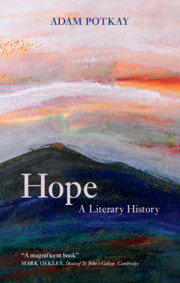Book contents
- Hope: A Literary History
- Hope
- Copyright page
- Contents
- Preface
- Introduction For and Against Hope
- 1 The Limits of Hope in the Ancient World
- 2 Eternal Hope: The Christian Vision
- 3 The Three Hopes of Humanism: Sacred, Profane, and Political
- 4 Something Evermore About to Be: Hope in the Romantic Era
- 5 Later Nineteenth-Century Responses to Romantic Hope
- 6 Modernism: Repetition, Epiphany, Waiting
- Notes
- Acknowledgments
- Index
1 - The Limits of Hope in the Ancient World
Published online by Cambridge University Press: 27 January 2022
- Hope: A Literary History
- Hope
- Copyright page
- Contents
- Preface
- Introduction For and Against Hope
- 1 The Limits of Hope in the Ancient World
- 2 Eternal Hope: The Christian Vision
- 3 The Three Hopes of Humanism: Sacred, Profane, and Political
- 4 Something Evermore About to Be: Hope in the Romantic Era
- 5 Later Nineteenth-Century Responses to Romantic Hope
- 6 Modernism: Repetition, Epiphany, Waiting
- Notes
- Acknowledgments
- Index
Summary
For ancient authors, hope tends to be a dangerous thing. It can set us up for practical as well as moral failure. Elpis, the Greek word we translate as hope, is typically an attitude or emotion that is desiderative and goal-oriented, but it can also denote neutral expectation of evils as well as goods. The first author to treat elpis as an unqualified good, given a very specific object of desire (eternal life in Christ), is St. Paul, the earliest writer in the New Testament. Before him, good hopes – including eschatological hopes expressed in other ancient mystery religions – had to be designated as such to be distinguished from bad hopes, which preponderate in Greek literature. But the ancients recognize good hope, foremost in the competitive strife that defines public life. Hope could be seen as a necessary motive, linked to confidence and courage. The ancient world, especially in Jerusalem and Rome, knew also hope in a future ruler, a hope more soteriological than political. Whatever hopes might be expressed for the city-state or empire, the philosophical schools of antiquity developed the case against personal hope and passionate agitation.
- Type
- Chapter
- Information
- Hope: A Literary History , pp. 29 - 71Publisher: Cambridge University PressPrint publication year: 2022



